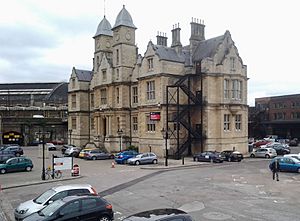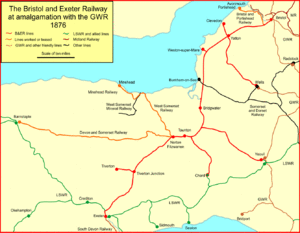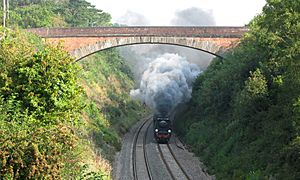Bristol and Exeter Railway facts for kids

Exeter in 1844. William Spreat's print shows the original Exeter station before the South Devon Railway was opened.
|
|
| Overview | |
|---|---|
| Headquarters | Bristol |
| Dates of operation | 1844–1876 |
| Successor | Great Western Railway |
| Technical | |
| Track gauge | 7 ft 1⁄4 in (2,140 mm) |
The Bristol and Exeter Railway (B&ER) was an English railway company. It was created to build a railway line connecting the cities of Bristol and Exeter. This railway used a special wide track called the broad gauge. Its main engineer was the famous Isambard Kingdom Brunel. The line opened in different parts between 1841 and 1844.
The B&ER worked closely with the Great Western Railway (GWR). The GWR had built its main line from London to Bristol. Together, these two railways formed a long route from London all the way to Cornwall.
The B&ER got caught up in the "gauge wars". This was a big fight between railway companies. They wanted to control different areas of the country. The B&ER used broad gauge, while its rival, the London and South Western Railway (LSWR), used a narrower track, which later became the standard size.
At first, the B&ER paid the GWR to run its trains. This saved the B&ER money because they didn't need to buy their own locomotives. But in 1849, this agreement ended. After that, the B&ER started running its own trains. It also built many smaller lines, called branches. These branches went to towns like Clevedon, Weston-super-Mare, Chard, and Tiverton.
The B&ER was very successful financially. But in 1876, it joined with the GWR. The combined company was then known as the Great Western Railway.
Contents
- Building the Railway: A Big Project
- Opening the Main Line: Connecting Cities
- The "Gauge War": A Battle of Track Sizes
- Running the Railway: Independent Success
- New Lines and Branches: Expanding the Network
- Changing Track Sizes: The Narrowing of the Gauge
- Joining Forces: Amalgamation and Beyond
- Train Services: Speed and Journeys
- Cool Engineering: Brunel's Designs
- The Railway's Path: Hills and Valleys
- Stations and Openings: A Timeline
- Locomotives: The Engines of the B&ER
- Images for kids
Building the Railway: A Big Project
The Great Western Railway (GWR) got permission to build its line in 1835. This line would connect London and Bristol. People in Bristol wanted a railway to Exeter. Exeter was an important city and port. It helped with trade to Europe. So, they started the Bristol and Exeter Railway. They easily raised £1,500,000 for the project in 1835.
Isambard Kingdom Brunel was chosen as the engineer. He was also the engineer for the GWR. His assistant, William Gravatt, surveyed the route. This led to a new law being passed in 1836. This law allowed the B&ER to build its railway. The law didn't say what size the tracks should be.
At first, it was hard to find enough money to build the railway. Many people who promised money didn't pay. But things got better in 1838. The company decided to use the broad gauge track in 1839. They saw how well it worked on the GWR.
By the end of 1839, the B&ER decided to focus on building the line from Temple Meads to Bridgwater. This would help them start earning money sooner. They also decided to let the GWR operate their line. This saved them from buying expensive trains. This agreement started when the line opened. The GWR would pay the B&ER rent.
Opening the Main Line: Connecting Cities
The first part of the line opened on June 14, 1841. It ran from Bristol to Bridgwater. This was just before the GWR finished its line from London to Bristol. This section was about 33.5 miles (54 km) long. It had two tracks. There was also a short single-track branch line to Weston-super-Mare. This branch used horses to pull the trains at first.
The first stations were Nailsea, Clevedon Road, Banwell, Weston Junction, Highbridge, and Bridgwater. Weston-super-Mare was the only station on its branch.
More money became available in 1841. So, work continued to finish the line. The railway opened in stages:
- Bridgwater to Taunton on July 1, 1842.
- Taunton to Beam Bridge on May 1, 1843. Beam Bridge was a temporary end point.
- Beam Bridge to Exeter on May 1, 1844. The Exeter station is now called Exeter St Davids.
When the line reached Exeter, the B&ER main line was complete. With the GWR, it formed a 194-mile (312 km) broad gauge line from London to Exeter. This was one of the longest lines at the time. The company was proud that they built it for the original budget of £2 million. This was very unusual back then!
The "Gauge War": A Battle of Track Sizes
The rival London and South Western Railway (LSWR) wanted to extend its line to Exeter. The GWR wanted to stop this. Back then, Parliament usually allowed only one railway line in an area. So, each company wanted their own lines to be approved.
The LSWR used a "narrow gauge" railway. The GWR and B&ER used "broad gauge." This big competition to control railway areas was called the "gauge wars."
The GWR tried to buy the B&ER in 1845. But the B&ER shareholders said no. The B&ER felt upset with the GWR. Brunel, who worked for both companies, decided to leave the B&ER in 1846. Charles Hutton Gregory took his place.
The B&ER joined with the LSWR to fight against the GWR's plans. Their efforts worked, and the GWR's plans were rejected. However, a financial crisis hit, and the B&ER also stopped its own expansion plans.
The "gauge war" continued. In 1852, the GWR and B&ER together proposed a new line. It would go from Maiden Newton to Exeter. This line would have been 10 miles (16 km) longer than the existing route. But this proposal was also rejected in Parliament.
Crediton and the LSWR: A Local Battle
In 1845, a railway was approved from Exeter to Crediton. This line was expected to be broad gauge and work with the B&ER. But the LSWR wanted to expand into Devon. They encouraged friendly relations with the smaller railway companies.
In 1847, the Exeter and Crediton Railway (E&CR) decided to work with the LSWR instead of the B&ER. This was a big surprise! The E&CR had been built using broad gauge. After some arguments, the B&ER agreed to operate the E&CR line in 1851. It became like a branch line for the B&ER.
The LSWR finally reached Exeter on July 19, 1860. They built their own station, Queen Street. It was more central than the B&ER station. The LSWR and B&ER eventually agreed to connect their lines. Narrow gauge rails were added to the line from Exeter to Crediton. LSWR trains started running on this shared line on February 1, 1862.
The Exeter (St Davids) station was improved in 1864. Taunton station was also updated in 1868. At Weston-super-Mare, the station was modernized in 1866. Work also started on the Bristol station in 1871. This was a big project and finished in 1878.
Running the Railway: Independent Success
The Bristol and Exeter Railway was very successful. Between 1844 and 1874, it paid its investors an average of 4.5% profit each year.
The B&ER started running its own trains in 1849. Before this, the GWR had operated them. Now, the two companies were completely separate. They still shared trains for through passengers.
The B&ER built workshops in Bristol in 1854. Here, they repaired and built locomotives. They also added large facilities for goods. The company installed the electric telegraph along its main line in 1852. This helped them communicate quickly. It was also one of the first British railways to use the "block system" for safety. This system keeps trains a safe distance apart.
In 1852, the company started building its main office building at Temple Meads in Bristol. It was designed by Samuel Fripp and opened in 1854.
New Lines and Branches: Expanding the Network
In 1845, the B&ER got permission to build several branch lines. These included lines to Clevedon, Tiverton, and Yeovil. They also built a direct connection at Bristol to the GWR line.
The Clevedon branch line opened on July 28, 1847. The Tiverton branch opened on June 12, 1848. The Tiverton branch went under the Grand Western Canal. Brunel built a special bridge, called an aqueduct, to carry the canal over the railway.
Work on the Yeovil branch from Durston was slow at first. But it finally opened for passengers on October 1, 1853. This line was later extended to connect with the GWR station in Yeovil in 1857.
The West Somerset Railway opened in 1862. It ran from Taunton to Watchet. The B&ER leased this line. It was later extended to Minehead in 1874. The B&ER also operated this extension.
The Somerset Central Railway opened in 1854. It ran from Highbridge to Glastonbury. It was a broad gauge line. The B&ER leased it for seven years. This line was later extended to Burnham-on-Sea and Wells. However, it later switched to narrow gauge and joined with another company, becoming the Somerset and Dorset Railway. It stopped working with the B&ER.
The Chard and Taunton Railway opened in 1866. The B&ER took over its construction. The Portishead branch opened in 1867. The B&ER also worked this line.
The B&ER built a line from Yatton to Wells. This broad gauge line opened to Cheddar in 1869 and to Wells in 1870. This line connected with the Somerset and Dorset Railway.
The Devon and Somerset Railway opened in stages, finishing in 1873. It ran from Norton Fitzwarren to Barnstaple. This was a broad gauge line with steep hills. The B&ER operated it.
A short line called the Bristol Harbour Railway opened in 1872. It connected the B&ER and GWR lines to the Floating Harbour in Bristol. It was built jointly by the GWR and B&ER.
Changing Track Sizes: The Narrowing of the Gauge
For a long time, the B&ER used only broad gauge tracks. But by the 1870s, it was clear that the narrower track size (4 feet 8.5 inches or 1,435 mm) had become the "standard" gauge. Most other railways used it.
This caused problems where different gauge lines met. Goods had to be moved from one train to another. This was called the "break of gauge." It was slow and expensive.
To fix this, the B&ER started adding narrow gauge rails to its main line. This created "mixed gauge" tracks. This meant both broad and narrow gauge trains could use the same line. This was a huge project!
Mixed gauge was installed from Bristol to Taunton by June 1875. The line to Exeter was finished in November 1875. The Cheddar Valley line was completely changed to narrow gauge by November 1875. The B&ER planned to convert the rest of its lines too.
Joining Forces: Amalgamation and Beyond
Because of the high costs of changing the tracks, the B&ER directors decided to join with another company. They talked with the Great Western Railway. An agreement was quickly made. The GWR would lease the B&ER from January 1, 1876. The B&ER officially joined the GWR on August 1, 1876. The GWR now owned the entire line from London to Plymouth.
Under GWR ownership, train services continued. But later, the GWR built a shorter route from London to Exeter. This new route opened in 1906. It was 34 miles (55 km) shorter. This meant the original B&ER line between Bristol and Taunton became less important for long-distance trains.
The GWR also made many improvements to the line between Taunton and Exeter in the 1930s. They added more tracks and made stations bigger.
Train Services: Speed and Journeys
The B&ER and GWR worked together to offer fast trains between London and Exeter. In 1846, the fastest train took 4 hours and 30 minutes for the 194-mile (312 km) journey. This was very fast for the time.
The B&ER section from Bristol to Exeter (87 miles or 140 km) took about 1 hour and 45 minutes in 1846. In 1871, it was even faster, taking only 94 minutes. The Bristol and Exeter Company, along with the GWR, had some of the fastest trains in the world!
Cheap day trips were very popular in the summer. For a small price, people could travel from Bristol to Weston-super-Mare or from Taunton to Watchet. Special platforms were even built to handle these large groups of travelers.
After the B&ER joined the GWR, new express trains were introduced. These included the "Zulu" and the "Jubilee." In 1890, "The Cornishman" express started running. By 1892, trains could carry passengers all the way from Manchester to Torquay.
From 1904, non-stop express trains ran from London to Plymouth. These were later called "The Cornish Riviera Express." The new, shorter route that opened in 1906 helped these trains go even faster.
Seaside holidays became very popular in the 20th century. Trains to Devon and Cornwall were very busy, especially on Saturdays. Many trains from London and other cities went to Weston-super-Mare. A new station was opened there in 1914 for holiday trains.
After World War II, holiday travel by train grew even more. But by the 1960s, fewer people took trains for holidays. Today, the Bristol to Taunton route is busy again with frequent services. The Weston-super-Mare loop and the Exeter and Crediton line are still open for local trains. The West Somerset Railway, which closed, has reopened as a heritage railway.
Cool Engineering: Brunel's Designs
William Gravatt was the engineer for the northern part of the line. William Froude supervised the section from Taunton to Exeter.
Near Weston-super-Mare, the railway crosses the Mendip Hills at Uphill. Here, a deep cutting has a large stone bridge called Devil's Bridge. It is 115 feet (35 meters) wide and built into the rock.
At Bridgwater, a special "Telescopic Bridge" was built in 1871. It carried a short industrial railway line over the River Parrett to the docks. The bridge could move sideways to let boats pass. An 80-foot (24-meter) section of track would slide away. Then, the main 127-foot (39-meter) bridge section would retract. This created a 78-foot (24-meter) wide channel for boats. The bridge was last opened in 1953. Parts of it are still there today as a historic monument.
The main line also crossed the River Parrett south of Bridgwater. Brunel built the "Somerset Bridge" here. It had a 100-foot (30-meter) arch. Brunel later replaced the original brick arch with a timber one. This was then replaced by a steel bridge in 1904.
Near Taunton, the River Tone was straightened to avoid building two bridges. West of Taunton, the line climbs steep hills called the Blackdown Hills. At the top, on the border of Somerset and Devon, is the 1,092-yard (998-meter) Whiteball Tunnel.
William Froude, the engineer for the western part of the line, helped design the curves of the track. He also created a new design for bridges that crossed the railway at an angle, like at Rewe and Cowley Bridge Junction near Exeter.
The Railway's Path: Hills and Valleys
After leaving Bristol, the main line had gentle curves and slopes until Taunton. It mostly ran through flat areas, like the Somerset Levels. It passed north-west of the Mendip Hills and south-east of the Quantock Hills.
From Taunton, the line became more challenging. It had steeper slopes and sharper curves. It crossed the side of the Blackdown Hills. There is a high point at Whiteball. Trains climbed for 10 miles (16 km) from Taunton to reach it. The last 3 miles (5 km) were quite steep, with a slope of 1 in 80. Going towards Bristol from Exeter, the climb to Whiteball was almost continuous.
Stations and Openings: A Timeline
Here are some of the main stations and when they opened. Some names changed over time. Openings after 1876, when the B&ER joined the GWR, are shown in italic.
- Main line (Opened to Bridgwater 1841; to Taunton 1842; to Beam Bridge 1843; and to Exeter 1844)
- Bristol; later became part of the larger Temple Meads station in 1874
- Bedminster; opened 1871
- Nailsea; renamed Nailsea and Backwell in 1905
- Clevedon Road; renamed Yatton in 1847
- Highbridge
- Bridgwater
- Taunton
- Wellington; closed 1964
- Tiverton Road; renamed Tiverton Junction in 1848; closed 1986
- Exeter.
- Clevedon branch (From Yatton; opened 1847; closed 1966.)
- Clevedon
- Weston-super-Mare branch (From Weston Junction; opened 1841; closed 1884; replaced by a new loop line)
- Weston-super-Mare
- Yeovil branch (From Durston; opened 1853.)
- Station details are on the Yeovil to Taunton Line article.
- Chard branch (From Creech St Michael; opened 1866; closed to passengers 1962.)
- Station details are on the Chard Branch Line article.
- Tiverton branch (From Tiverton Junction; opened 1848; closed 1964.)
- Tiverton
- Minehead branch (From Watchet Junction; opened to Watchet 1862, and to Minehead 1874. Closed 1971, reopened as a heritage line 1976.)
- Station details are on the West Somerset Railway article.
Locomotives: The Engines of the B&ER
At first, the Great Western Railway provided the locomotives for the B&ER. But after 1849, the Bristol and Exeter Railway started using its own engines. They built engine sheds at major stations. Workshops were set up in Bristol in 1854 to repair and build locomotives.
James Pearson became the Locomotive Engineer in 1850. He designed several types of tank engines. His most famous designs were the large 4-2-4T locomotives, which were introduced in 1854.
Images for kids










